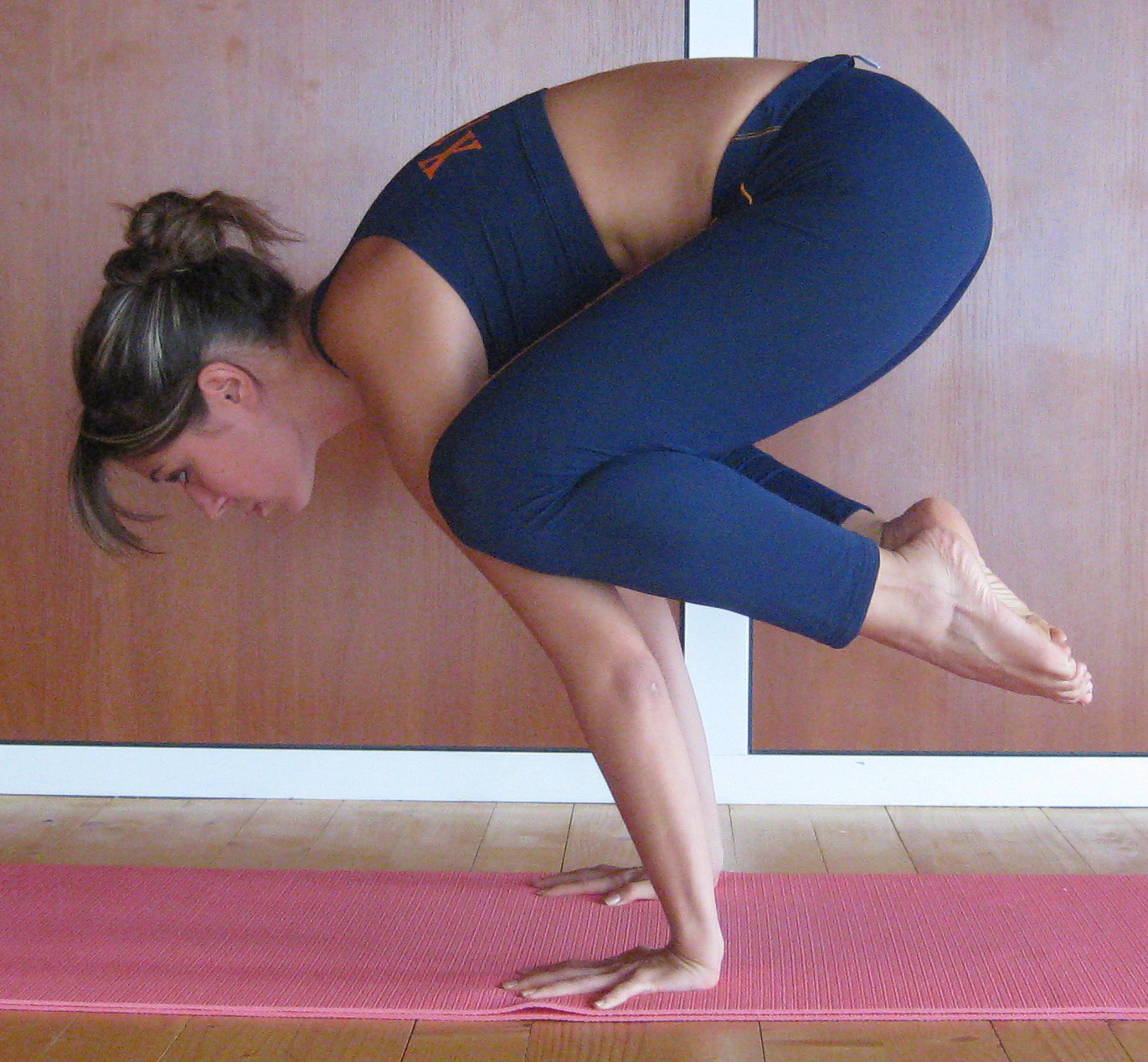Bakasana on:
[Wikipedia]
[Google]
[Amazon]
 Bakasana (Crane pose) (, ), and the similar Kakasana (Crow pose) (, ) are balancing asanas in hatha yoga and modern yoga as exercise. In all variations, these are arm balancing poses in which hands are planted on the floor, shins rest upon upper arms, and feet lift up. The poses are often confused, but traditionally Kakasana has arms bent, Bakasana (the crane being the taller bird with longer legs) has the arms straight.
Bakasana (Crane pose) (, ), and the similar Kakasana (Crow pose) (, ) are balancing asanas in hatha yoga and modern yoga as exercise. In all variations, these are arm balancing poses in which hands are planted on the floor, shins rest upon upper arms, and feet lift up. The poses are often confused, but traditionally Kakasana has arms bent, Bakasana (the crane being the taller bird with longer legs) has the arms straight.
File:Kakasana in Sritattvanidhi.jpg, Kakasana, Crow Pose, in the 19th century '' Sritattvanidhi'' manuscript in the Mysore Palace
File:Pose labelled Bakasana from Vyayamadipika.jpg, Engraving of "Bakasana" in the 1896 ''Vy─üy─üma D─źpik─ü'' (Light on Exercise)
Etymology and origins
The names for the asanas come from theSanskrit
Sanskrit (; stem form ; nominal singular , ,) is a classical language belonging to the Indo-Aryan languages, Indo-Aryan branch of the Indo-European languages. It arose in northwest South Asia after its predecessor languages had Trans-cultural ...
words ("crane") or ("crow"), and meaning "posture" or "seat".
While different yoga lineages use one name or another for the asanas, Dharma Mittra makes a distinction, citing Kakasana as being with arms bent (like the shorter legs of a crow
A crow is a bird of the genus ''Corvus'', or more broadly, a synonym for all of ''Corvus''. The word "crow" is used as part of the common name of many species. The related term "raven" is not linked scientifically to any certain trait but is rathe ...
) and Bakasana with arms straight (like the longer legs of a crane). B. K. S. Iyengar's 1966 '' Light on Yoga'' describes only Bakasana, with straight arms. In Sivananda Yoga, Swami Vishnudevananda's 1960 '' Complete Illustrated Book of Yoga'' describes only Kakasana, with bent arms. However, practitioners in the west often mistranslate the Sanskrit "Bakasana" as "Crow Pose".
These balancing poses can be dated at least to the 17th century '' Hatha Ratnavali'', where Bakasana is number 62 of the 84 poses said to have been taught by Shiva
Shiva (; , ), also known as Mahadeva (; , , Help:IPA/Sanskrit, ╔É╔Ža╦Éd╠¬e╦É╩ő╔Éh and Hara, is one of the Hindu deities, principal deities of Hinduism. He is the God in Hinduism, Supreme Being in Shaivism, one of the major traditions w ...
.
The 19th century '' Sritattvanidhi'', created for a Raja of Mysore, describes and illustrates both Kakasana and Bakasana. Norman Sjoman suggests that Krishnamacharya, teaching in the Mysore Palace, may have derived asanas including these from the 1896 ''Vy─üy─üma D─źpik─ü'' exercise manual.
In his 1969 book ''Asana Pranayama Mudra Bandha'', Swami Satyananda Saraswati of the Bihar School of Yoga uses the name Bakasana for a different pose entirely ( Dandayamana Janushirsasana, pose 5 in Bikram Yoga).
Description
These asanas are arm balances. In Crow Pose, the knees rest on the bent elbows. In Crane Pose, the elbows are straight and the knees are just above the shoulders, requiring flexibility in the hips. According toB.K.S. Iyengar
Bellur Krishnamachar Sundararaja Iyengar (14 December 1918 ÔÇô 20 August 2014) was an Indian teacher of yoga and author. He is the founder of the style of yoga as exercise, known as "Iyengar Yoga", and was considered one of the foremost Modern ...
there are two techniques for entering the poses. The simple method is by pushing up from a crouching position. The advanced method is to drop down from Shirshasana (yoga headstand) Some vinyasa yoga practitioners jump in and out of Crane/Crow via Downward-Facing Dog Pose. This can be practised in stages.
Variations
Asymmetric variations include: * Parsva Bakasana (Side Crane Pose) in which one thigh rests on the opposite upper arm and the other leg is stacked on top of the first. * Eka Pada Bakasana/Kakasana (One-Legged Crane/Crow Pose respectively) in which one leg remains in Bakasana while the other extends straight back.Preparation
The arms and shoulders can be strengthened for Crane/Crow by practising moving from High Plank to Low Plank. Other preparatory poses include Downward Dog Pose, Virasana (Hero Pose), and Malasana (Garland Pose).Claims
Twentieth century advocates of some schools of yoga, such as B. K. S. Iyengar, made claims for the effects of yoga on specific organs, without adducing any evidence. Iyengar claimed that this pose "strengthens the arms and abdominal organs since the latter are contracted."See also
*Bhujapidasana
Tittibhasana () or Firefly pose is an arm-balancing asana with the legs stretched out forwards in hatha yoga and modern yoga as exercise. Variants include Bhujapidasana, with the legs crossed at the ankle, and Eka Hasta Bhujasana, with one leg str ...
ÔÇô a similar hand-balancing pose, with the feet crossed in front of the body
* Tittibhasana ÔÇô a hand-balancing pose with the feet stretched straight out in front
Notes
References
Sources
* * * {{Hatha yoga Balancing asanas Medieval Hatha Yoga asanas Core strength asanas